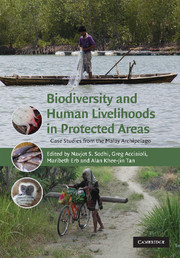Book contents
- Frontmatter
- Contents
- List of contributors
- Acknowledgements
- 1 General introduction
- Part I Conservation needs and priorities
- 2 Introduction to Part I
- 3 Delineating Key Biodiversity Areas as targets for protecting areas
- 4 A Master Plan for Wildlife in Sarawak: preparation, implementation and implications for conservation
- 5 Indonesia's protected areas need more protection: suggestions from island examples
- 6 Birds, local people and protected areas in Sulawesi, Indonesia
- 7 Importance of protected areas for butterfly conservation in a tropical urban landscape
- 8 Biodiversity conservation and indigenous peoples in Indonesia: the Krui people in southern Sumatra as a case study
- 9 Involving resource users in the regulation of access to resources for the protection of ecosystem services provided by protected areas in Indonesia
- 10 Conclusion to Part I
- Part II Conservation with and against people(s)
- Part III Legal and governance frameworks for conservation
- 29 General conclusion
- Index
- References
7 - Importance of protected areas for butterfly conservation in a tropical urban landscape
from Part I - Conservation needs and priorities
Published online by Cambridge University Press: 12 November 2009
- Frontmatter
- Contents
- List of contributors
- Acknowledgements
- 1 General introduction
- Part I Conservation needs and priorities
- 2 Introduction to Part I
- 3 Delineating Key Biodiversity Areas as targets for protecting areas
- 4 A Master Plan for Wildlife in Sarawak: preparation, implementation and implications for conservation
- 5 Indonesia's protected areas need more protection: suggestions from island examples
- 6 Birds, local people and protected areas in Sulawesi, Indonesia
- 7 Importance of protected areas for butterfly conservation in a tropical urban landscape
- 8 Biodiversity conservation and indigenous peoples in Indonesia: the Krui people in southern Sumatra as a case study
- 9 Involving resource users in the regulation of access to resources for the protection of ecosystem services provided by protected areas in Indonesia
- 10 Conclusion to Part I
- Part II Conservation with and against people(s)
- Part III Legal and governance frameworks for conservation
- 29 General conclusion
- Index
- References
Summary
Introduction
Urbanization has become the globally prevailing source of land-use change (Fig. 7.1; United Nations Centre for Human Settlements 1996). Unlike other kinds of habitat disturbance, such as commercial logging, urbanization often irreversibly replaces natural habitats (e.g. primary forests) with persistent artificial ones (e.g. human cities), resulting in long-lasting negative impacts (e.g. species extinctions) on the native biodiversity (Stein et al. 2000). Due to the traditional focus of conservation research on ‘natural’ ecosystems (e.g. undisturbed forests), urban ecology has received relatively little emphasis from conservation biologists (Miller & Hobbs 2002). Recently, some authors have argued that conservation planning should include reconciliatory measures that enable human activities to proceed with minimum displacement of the native species (Dale et al. 2000; Miller & Hobbs 2002; Daily 2003; Rosenzweig 2003). An example of such a conservation strategy is the creation and maintenance of artificially revegetated habitats (e.g. urban parks), where certain native species can persist (Kendle & Forbes 1997).
As many countries in Southeast Asia are rapidly developing, urban areas will likely be a common feature of the regional landscape. Therefore, a current challenge is to understand the individualistic responses of species to urbanization in Southeast Asia, including the mechanisms underlying such responses, in order to identify vulnerable species and to develop effective measures for their conservation. Furthermore, it is critical to evaluate the effectiveness of different habitats, including artificially revegetated urban parks, in maintaining the diversity of native species in urban landscapes.
- Type
- Chapter
- Information
- Biodiversity and Human Livelihoods in Protected AreasCase Studies from the Malay Archipelago, pp. 95 - 110Publisher: Cambridge University PressPrint publication year: 2007

